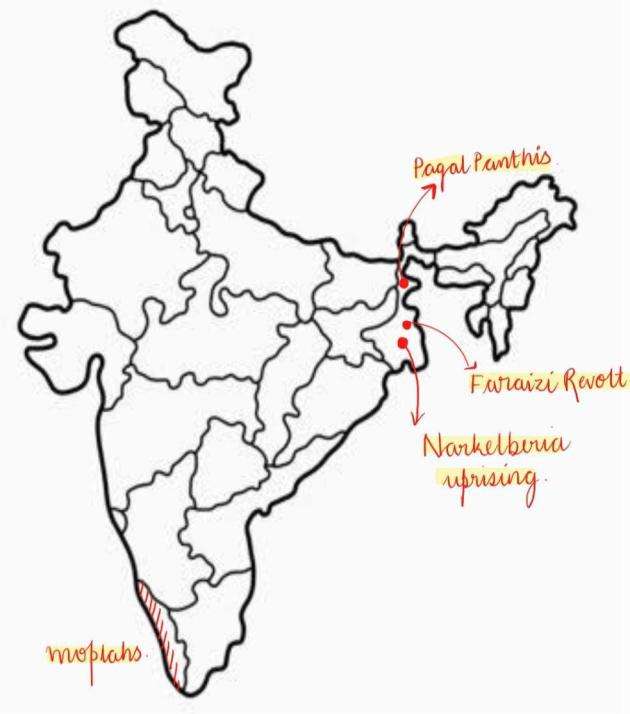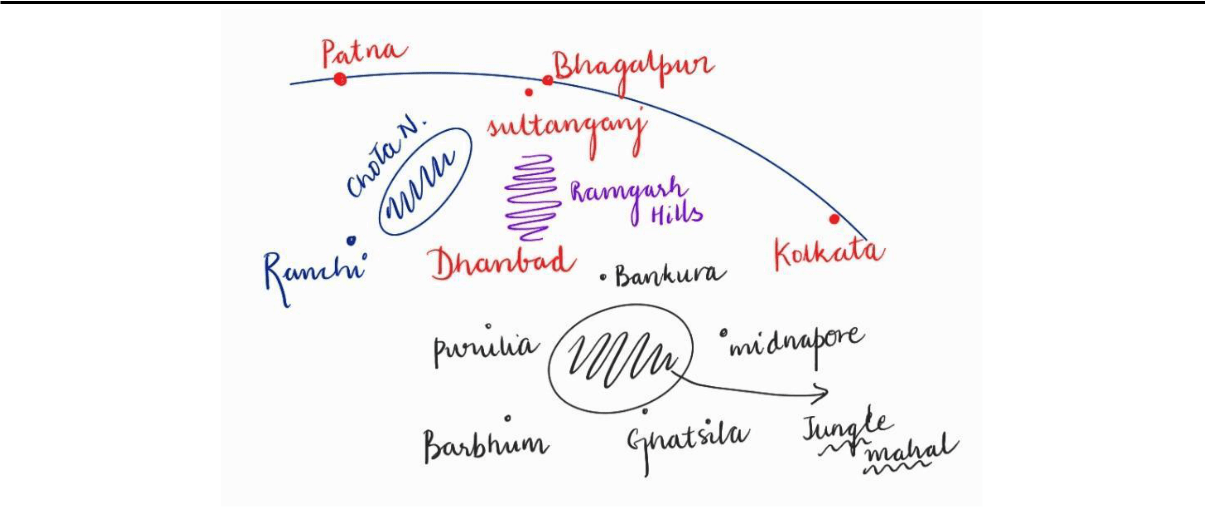Timeline of Uprisings Before 1857: A Closer Look at Civil Revolts in Pre-Colonial India
TIMELINE FOR UPRISING BEFORE 1857
CIVIL UPRISINGS : Time Frame, Location, Reason, Leaders, Misc.
Not Peasants, Tribals and Sepoy Mutiny. Semi – Feudal, Traditional and Backward Looking. Restoring the earlier forms of rule and social relations.
1772 – 1785 : Warren Hastings. 1786 – 1793 : Lord Cornwallis. 1798 – 1805 : Richard
Wellesley. 1813 – 1823 : Francis Hastings. 1848 – 1856 : Lord Dalhousie.

1763 – 1800 : Sanyasi Revolt / Fakir Rebellion – of Eastern Bengal. Dual government. 1769 – great famine and small pox. Started raids, Hindu – Muslim unity. Leaders : Manju Shah and Debi Chaudhurani. Warren Hastings suppressed it.
Anandamath and Devi Chaudhurani – written by BankimChandra Chattopadhyay.
1766 – 74 : Revolt in Midnapore and Dhalbhum – Jungle Mahal. Due to introduction of New Land Revenue System. Leaders : Damodar Singh and Jagannath Dhal.
1769 – 99 : Revolt of Moamarias. Moamarias raised internal battle against Ahoms, followed teachings of Aniruddhadeva. In the moment, King of Darrang, Burkandaze revolted against them. Ahoms seek to British for help. HQ : Bhatiapur.
1781 : Gokharpur, Basti and Bahraich.
Reason for Revolt – Warren Hastings made English officers as Izaradars in Awadh.
Oppressive and excessive demand of revenue made region panic – stricken.
1758 – Treaty between English and Ruler of Vizianagaram to jointly oust French.
1765 – Northern Circars annexed. Tried to suppress Vizayaramaraju.
1794 : Vizianagaram Revolt : Battle of Padmanabham.
1799 – Conquest of Mysore.
Revolt by Dhundia in Bednur : He was a maratha – Organised a force of anti – british elements. 1800, he was killed under Wellesley.
Kerala Varma Pazhassi Raja ( Kerala )
After Third Anglo Mysore War, English paramountcy over Kottayam. English appointed Vira Varma – levied exorbitant rates of tax on the peasants.
Resistance by Peasants led by KVPR.
1800 – 1805 = British v/s KVPR + Pathan + Mopilla + Nairs.
Civil Rebellion in Awadh (1799 )
Wazir Ali Khan replaced by Saadat Ali Khan II – In retailation, he killed George Cherry. Incident k/a Massarce of Benares.
Ganjam and Gumsur Uprisings : Zamindars revolted.
Leaders : Strikara Bhanj, Jlani Deo, Jagannath Deo.
Uprising in Palamau : ( Jharkhand) Bhukhan Singh (Chero chief ) rose rebellion.
Suppressed by Colonel Jones.
POLIGARS’ REVOLT
Governor = Nayak and Poligar = exercised autonomy.
Important centres : Tinneveli, Madurai, Sivaganga, Arcot.
1781 : Nawab of Arcot gave management of Tinneveli and Carnatic to British, making Poligars insecure.
First Phase ( 1795 – 1799 ) Leaders : Veerapandia Kattabomman and Subramania Pillia and Soundara Pandian.
Second Phase ( 1801 – 1805 ) : Poligars at Palamcotta, Leader = Oomathurai. Fort of Panjalankurichi.
1803 : Started as poligars deprived Poligars of their right to collect Kaval fees.
Later suppressed.
Uprising in Haryana :
1803 Treaty of Surji – Anjungaon, not accepted by the locals.
1809 – British attack on Fatehabad, Sirsa and Rania. Their in no British acceptance.
1810 – finally suppressed and Fort of Hansi = military cantonement.
Diwan Velu Thampi’s Revolt :
1805 – Travancore signed subsidiary alliance. PM = Velu Thampi + Nair fought against British.
Bundelkhand Disturbances : (1808 – 12)
Province conquered by British during Second Anglo – Maratha war was put within Presidency of Bengal. Resistance to the new government. Bundela chief v/s British.
Parlakimedi Outbreak (1813 – 1834) in Ganjam, Orissa. Resistance from Zamindars and Rajas. Ruler = Narayan Dev v/s Colonel Peach. Pacified by George Russell.
Kutch Rebellion : Gujarat. Ruler = Bharmal II supported by Arab and African soldiers v/s British ( because British interfered in internal feuds ) Defeat of Bharmal. British resident governing as de facto ruler with help of regency council. Resentment among people, demanded restoration of Bharmal II. Later – conciliatory policy.
Rising at Bareilly (1816) = immediate cause = imposition of police tax. Mufti Mohd. Aiwaz gave petition to magistrate, turning the issue religious. Bloody scuffle took place – the uprising was only suppressed with heavy deployment of military forces.
Upsurge in Hathras, near Aligarh (1817 ) : Dayaram Taluqdar had a base in fort of Hathras. Due to increasing high revenues, Dayaram committed acts of hostility. Company attacked Hathras →submission of Dayaram.
Paika Rebellion : (1817) a.k.a. Khurda uprising. Raja = Brij Kishore Dev. Earlier, he was in conflict with Marathas, forced to give possession to them ( parganas, Jagannath Temple etc. )
Mukund Dev during Second Anglo Maratha will support British. 1803 – occupation of Orissa by British.
Mukund Dev, then tried to make alliance with Marathas against British. ( he was removed from position of Raja and got Jagannath Temple under control )
Hence, Orissa under British. Extortionist land revenue policy, introduction of silver currency, abolition of cowrie currency, rise in prices and British salt monopoly. Therefore = PAIKA REBELLION ( foot soldiers ) in 1817 as their power and prestige reduced. Leader = Bakshi Jagabandhu. Campaign = No rent.
- Police Stations attacked, British bringing Amnesty Scheme, Disturbances till 1825. At last, Conciliatory Policy.
Waghera Rising (1820) : After Third Anglo Maratha War, resentment against Alien Rule compelled Waghera of Okha Mandal to take arms.
Ahom Revolt (1828) : After First Burma War and Treaty of Yandabo, British was suppose to withdraw from Assam. But they did not.
Therefore, Gomdhar Konwar ( Ahom Ruler ) sparked off rebellion. Company decided to follow conciliatory policy. New Ruler = Purendra Singh.
Finally Assam annexed in 1838 – non payment of revenue.
Surat Salt Agitation : In 1844, British raised Salt duty from 50 paise to 1 rupee. In 1848, introduction of Bengal Standard Weights and Measures. People resorted to Boycott and passive resistance.
Kolhapur and SawantWadi Revolts : Gadkaris were hereditary military class, garrisoned in Maratha Forts. Garrisons disbanded in 1844, causing unemployment and revolt. Lastly, suppressed.
1820, Wahabi Movement : Punjab areas. Leader = Syed Ahmed of Rai Bareilly, inspired by teachings of Abdul Wahab and Shah Waliullah. Wanted to convert India from Dar-ul- Harb to Dar -ul- Islam. Technically, it was a movement against Sikhs, Ranjit Singh. (Jihad)
1849 = Annexation of Punjab. Now, a movement against British. Even took part in Armed Revolt 1857. Disturbances till 1890s.
Sithana chosen as a base for operations. Important centre = Patna, Hyderabad, Madras, Bengal, UP, Bombay.
1840, Kuka Movement : Founder Bhagat Jawahar Mal ( Sian Saheb ), after death of Ranjit Singh. Later leader = Ram Singh. A religious purification movement ( for Sikhism ) => women status improved, widow remarriage, inter caste marriage, abolish caste system, no meat and alcohol.
Punjab annexed in 1849 = Political agenda = concepts of Swadeshi, boycott and non- cooperation were propagated. Suppressed in 1872. Ram Singh deported to Rangoon.
Peasants Movement with Religious Overtones

1820’s Narkelberia Uprising : Led by Titu Mir – taking up the cause of Muslim tenants against Hindu zamindars and English.
Reason = Imposition of beard tax on Faraizis and British Indigo Planters. Often considered first armed peasant uprising against British.
Later, it merged in Wahabi Movement.
1825 – 1836 Pagal Panthis : Semi religious. (Religion + Political ) in MymenSingh District, impacted Hajong and Garo Tribes. Founder = Karam Shah. Pagal Panthis refused to pay rent above a certain limit. Therefore, Tenants v/s Zamindars. Later, suppressed.
Faraizi Revolt, Faridpur : followers of Muslim Sect. Same philosophy as Wahabis. Founder = Haji Shariatullah and his son Dudu Miyan. Took cause of Tenants. Later, joined Wahabi Movement.
Moplah Uprisings : Moplah of Malabar, 22 rebellions took place b/w 1836 and 1854. None successful. Second Moplah uprising ( Muslim overtone )organised by Congress and Khilafat supporters during NCM. By 1921, they had been subdued.
Tribal Revolts
- Mainland Revolt.
- Frontier Revolt.
Hunter gatherers, Pastoral, Shifting Cultivation, Public ownership, ( Mundas believe in KhantKutti System ) Cultural autonomy.
Company movement into Tribal areas. Outsiders called as = Diku, Suds.
Characteristics : Violence, Traditional weapons, not against everyone, Messiah like figure within community.

The Pahariyas :
Background : lived in Rajmahal hills ( hunter – gathering ) ; they were hostile to outsiders. By 1770’s British asked Santhals to migrate into Pahariya region and practice agriculture.
1778 – 1st rebellion led by Raja Jaggannath. British initiated policy of pacification and few paharias withdrew deep into mountains.
Revolt by Tilka Manjhi / Jabra Paharia was against British Divide and Rule policy. Tactics used = Guerrilla warfare. Considered as the first Advasi leader to take arms against British.
Jungle Mahal Revolt / Chuar Uprising : between Chota Nagpur and Bengal.
Chuars = Bhumij Tribes.
1767 – British resident came in, destruction of Mud Forts. 1768 – Jagannath Singh
took leadership against British. It came as a reaction to increase of revenue of Jungle
Zamindars. Paiks and Chuars participated.
Other leaders – Durjan Singh ( Chuar II) – 1798.
Tamar Revolt : in Chotanagpur. Leader = Bholanath Sahay. Munda Tribes too joined it. Suppressed by Lt. Cooper.
Kol Mutiny (1831) : in Chotanagpur. Kols were autonomous. The trouble started with large-scale transfers of land, heavy tax. Leadership by Buddho Bhagat.
Ho and Munda Uprising : (1820 – 27 ) : Chotanagpur. Raja of Parahat organised his Ho tribes. Initial fight = revenue policies and outsiders 1831 = joined by Mundas. ( Birsa Munda )
Santhal Rebellions (1855): Earlier Paharias dominated Rajmahal Hills, Santhals were called by British for agricultural purposes to Raj Mahal.
Paharias v/s Santhals was battle b/w hoe and plough. British worked out a compromise = Damin -i- koh. Portion of foothills with Santhals. The Paharias force to retreat to higher hill tracts.
Overtime, Santhals started losing the land they worked upon. Permanent settlement proved disastrous for agriculturist. Diku charged very high interest. Construction of railways. Ultimatum served to Zamindars → The rebellion started called ‘hul’. Under
Sidhu and Kanhu Murmu (Phulo and Jhano also participated) against moneylenders, landlords and British.
Suppressed violently and creation of Santhal Pargana.
Khond Uprising : Odisha. Led by Chakra Bisoi. Reasons = oppose the suppression of human sacrifice, new taxes, entry of Zamindars.
Koya Revolt : Odisha. ( 1806 -1886 ) Under Tomma Sora.
Bhil Revolt : Western Ghats. The passes controlled by Bhils. Famine. Economic Distress. Misgovernance by British. Guru Govind helped Bhils of South Rajasthan to organise Bhil Raj in 1913.
Koli Risings : Ahmednagar districts. Under Marathas, they looked after forts. Large scale unemployment forced them to Revolt.
Ramosi Risings : Satara under Chittur Singh ( unemployment and Banishment of Raja Pratap Singh ) Other centres = Poona and Kolhapur.
Tribal Movements of North East :
Khasi Uprising : (1830s) Leader = Tirath Singh. Reason = construction of road linking Brahmaputra Valley with Sylhet.
Singphos Rebellion : Leader = Nirang Phidu. Other Revolts : Mishmis, Khampti and Lushais Revolt.
